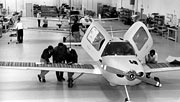
The Long Boom: Duluth's Renaissance
by Bob Kelleher
May 2000
For more than a century, Duluth's economy has swung with the fortunes of logging
and mining. Since a devastating recession in the early 1980s, city officials
have worked hard to develop new industries to broaden the city's job base and
lessen Duluth's dependance on timber and taconite. New employers are creating an
impressive number of jobs, but economists say there's still a long way to go
before new startups rival the business muscle of taconite and timber.
WHEN THE NATION PROSPERS,
the nation's paper and steel makers prosper. When
steel and paper do well, Duluth does well. And recently Duluth has been doing
very well. Regional economist Richard Lichty says the city's unemployment rate,
now bobbing around four percent, is unprecedented in recent times.
"We have historical low
unemployment over the last 20 or 30 years, certainly relative to
the early '90s," says Lichty. "Our unemployment is higher than the rest of the state; it's
higher than the Twin Cities, but it's very low for us."
 |
 |

|
|
Cirrus moved to Duluth
four years ago with 24 employees and an idea. The company has just
begun producing a general aviation aircraft unlike anything else in the market.
Click for larger image.
|
|
 |
| |
A recovery in taconite mining, and stability in paper production have helped
restore the economic base to Duluth and Northeast Minnesota. But Duluth is also
awash in new jobs in health care, retail sales and even manufacturing.
Today, Duluth workers might be employed by a high-tech software firm in the
city's new technology village; or they might be building airplanes or servicing
jetliners in the region's expanding aircraft industry.
Aviation is literally taking off, much like this four passenger SR-20 airplane,
leaving Cirrus Design's new airplane production plant.
"We could have located this company anywhere in the nation, and we choose
to be in Duluth," says Bill King, vice president of finance at Cirrus Design.
Cirrus moved to Duluth
four years ago with 24 employees and an idea. The company has just
begun producing a general aviation aircraft unlike anything else in the market.
It's composite-fiber body and full-plane parachute have turned heads and drawn
orders.
More than 400 people work at Cirrus today, with 15 or 20 new
hires every week. In a tight labor market, it can be hard to recruit new
employees, but King says that hasn't yet been the case here.
"People really like what we have to
offer. They really sense that what we're doing is changing the entire industry,
right here in Duluth, and it's a terribly exciting time, and the growth is
exciting," says King.
King says Cirrus Design will have to double the size of its facility within a
couple of years, with employment likely nudging 600 workers.
Half a mile from Cirrus's production plant is Northwest Airlines' jet
maintenance base. It's a new facility, lured here in the early 1990s to service
Northwest's newest fleet of Airbus passenger jets. Northwest promised 350 jobs, but has produced more than 400, and there's a real
possibility of more.
Economist Richard Lichty says combined with other important developments in the
regional economy, such as health care and retail sales, it all points to
Duluth's emergence as a regional center drawing business from three states.
But it's production jobs that drive an economy. The kind of jobs that take raw
materials and make them into something more valuable. Lichty's concerned
those traditional blue-collar factory jobs are at best, just holding on.
"Those were relatively high paying jobs," Lichty notes. "So income per capita, wages and
salaries per capita have not increased like the number of jobs and other things
have. I'd say that, if I were to point to an area of concern, that would be it."
And of the blue-collar jobs remaining in Duluth, many pay wages lower than
comparable jobs in larger communities. Nate Schilling works in a local foundry,
making hand tools. A part-time college student, and life-long resident,
Schilling says he loses friends and co-workers, down Interstate 35, to more
lucrative work in the Twin Cities.
Despite today's prosperity, Schilling - like many locals - remembers the hard
times, not many years ago. There's an attitude of economic scepticism; a
belief that in this area, good times quickly fade to bad. Schilling says there's
little faith that the community's ever far from shutdowns and layoffs. "A lot of people are worried about what's going to happen, because there hasn't been a whole lot of stability," he says.
It's not an uncommon fear. Jobs drain across the region with every market dive
in iron or timber. Despite the city's best efforts, a typical Duluthian in a
mining, timber, or paper-related job maybe driving the locomotive pulling
taconite trains; or maintaining paper making machines in Consolidated Paper's
West Duluth mill. Timber and taconite remain two of the
traditional bases for Duluth's overall economy.
That's no surprise to Ann Glumac, former deputy commissioner of the Iron Range
Resources and Rehabilitation Board, who's now president of the Iron Mining
Association of Minnesota.
"A great number of people in Duluth owe their jobs, whether they know it
or not, to the mining industry," she points out. "The iron mining industry in Minnesota,
encompasses hundreds and hundreds of businesses, many of them located in Duluth
and the Duluth environment."
Glumac says there's a several-hundred-year supply of taconite in Northeast
Minnesota, still waiting to be mined. Pending unforseen catastrophe or new
restrictive legislation, area forests should continue providing wood and pulp
for the region's paper and sawmills. It may be a very long time before taconite
or timber are unseated as the region's leading industries.
![]()
![]()
![]()

![]()
